As we ring in 2016, it’s time to make sure visual storytelling is a top priority. The importance of images and videos in marketing skyrocketed in 2015, and it will only continue to climb.
In a recent visual asset management survey by the CMO Council, in partnership with Libris by PhotoShelter, top marketing executives said video, infographics and photography will play an increasingly important role in the coming year.

The good news is that brands created some incredible content in 2015. As you build your content marketing calendar for 2016, you have plenty of inspiration. Check out the fantastic examples below, and steal these ideas to power your visual content in 2016.
The Top Ten Visual Content Marketing Ideas to Steal in 2016
Shift the Focus: Emily’s Oz
Sometimes real stories of your customers have more heart than the ones you could brainstorm around the office.
In this campaign from Comcast, the company shifts the focus away from Xfinity’s new talking guide onto Emily, a little girl who loves to watch movies even though she’s blind.
The video draws you into Emily’s incredible imagination and illustrates her favorite movie, The Wizard of Oz, from her perspective. At the very end, the spot mentions how Xfinity’s new talking guide will make it easier for people with visual disabilities to find their favorite movies. Isn’t this beautiful story more compelling than a spot filled with actors showing how the talking guide works?
And, if you follow the call to action to visit EmilysOz.com, you’ll find not a sales pitch, but more moving visual content about Emily and the production of Emily’s Oz.
By shifting the focus to Emily, Comcast pulls at our heartstrings and immerses us in the product’s impact. We are charmed by Emily, and we cheer for her when we find out that now, she can delight in her favorite movie with ease.
The Takeaway: Think about how your brand improves the lives of the people it serves. How is your brand making a difference? Shift the focus away from your products and services onto the people who benefit from them. Think impact.
Create Derivative Content: #Justino
The Spanish national lottery’s holiday campaign wowed viewers from all over the world.
They started with this heartwarming video, the story of a nightshift factory worker who delights his daytime coworkers with surprises, and is rewarded in the end with the biggest surprise of all. Once they had this video, they could create derivative content like shorter videos and photos to share on social media.
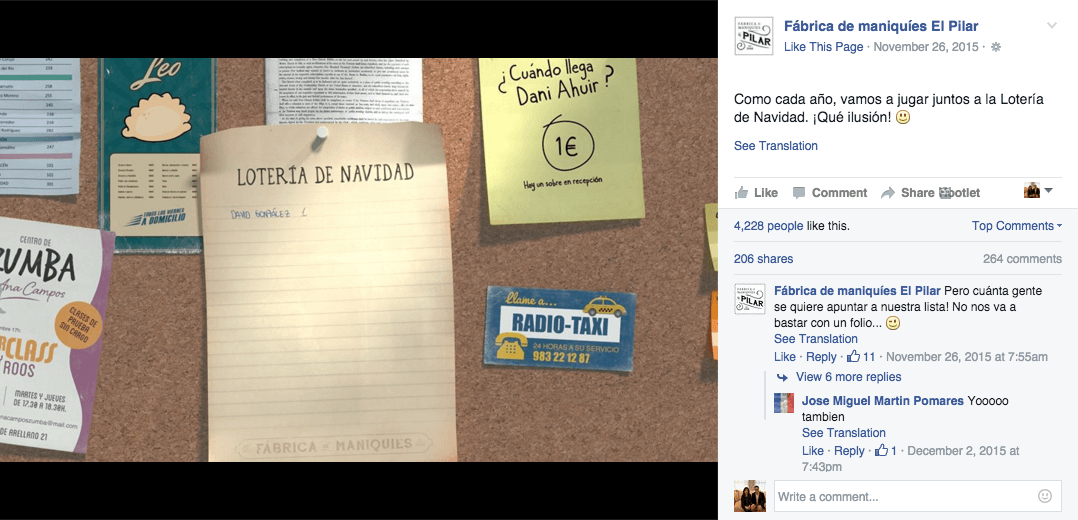
But the Spanish national lottery took derivative content to the next level, creating social media accounts specific to the campaign. Justino had his own Instagram account, and the mannequin factory had its own Facebook page. By creating these channels, the lottery invited the video’s viewers into the story. They could comment on their favorite scenes from the video or guess what color the dress was. All the while, they generated buzz for the original piece of content, #Justino.
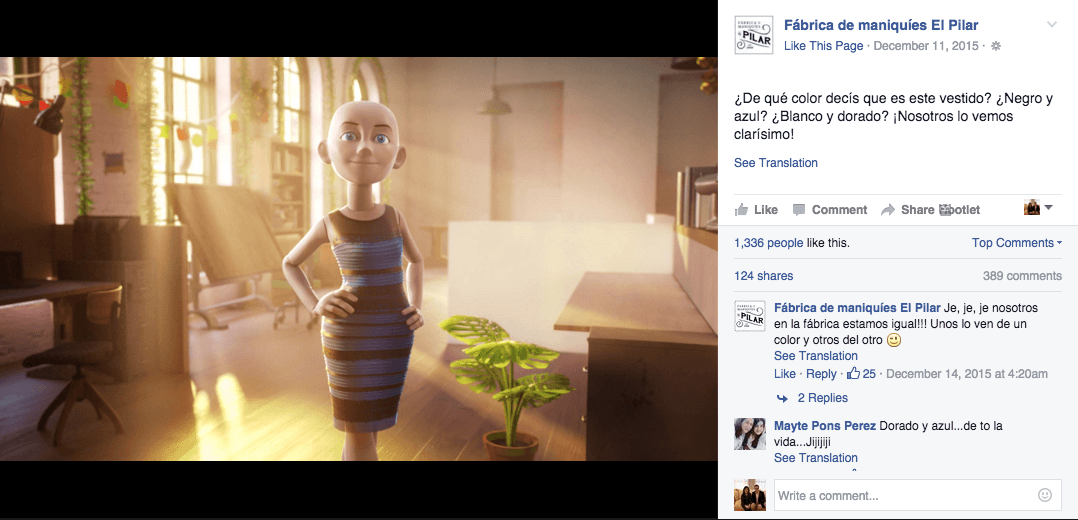
The Takeaway: Start with one piece of fantastic content. Then, build around it. Get creative with adding on to the story, inviting your audience to join in the conversation, and sharing derivative content across channels.
Go Live: #ComeSeekLive
Royal Caribbean tapped into the power of Periscope to take people from all over the world on a virtual voyage. The live video streams were broadcast not only on social media, but also on billboards around New York City.
The cruise line launched the project in hopes that people who had never thought of cruising before might see the live feed and think, “I wish I was there right now.” The campaign allowed Royal Caribbean to reach a new generation of adventure-seekers.
“COME SEEK LIVE is an exciting way for Royal Caribbean to challenge the misperceptions travelers have about the cruise industry,” Chief Marketing Officer Jim Berra said on Royal Caribbean’s blog. “We are continually evolving the experience across our fleet, designing adventures that inspire and excite our travelers. It is natural that we would bring this innovation to the transformation of our marketing as well, especially as we recognize that millennials require us to communicate with them using new channels.”
The live aspect of this campaign created a sense of authenticity. Royal Caribbean followed real travelers on a real cruise, and shared an unedited look at the experience. Not a bad way to take on naysayers’ misconceptions about cruising.
The Takeaway: Live broadcasting is an intimidating business. But if your brand seizes the right opportunity and does it well, it can surprise and amuse your fans and create a sense of genuine communication between you and your audience.
Create Image Lists: 52 Places to Go in 2015
Lists posts are the highest performing content format, driving 5 to 10 times more shares than other formats, according to BuzzSumo. When you combine lists with images, which also play a huge role in driving engagement, you have a recipe for viral content.
The New York Times Travel section’s 52 Places to Go in 2015 is a fantastic example of a list post. The piece garnered 522,000 shares, according to BuzzSumo.
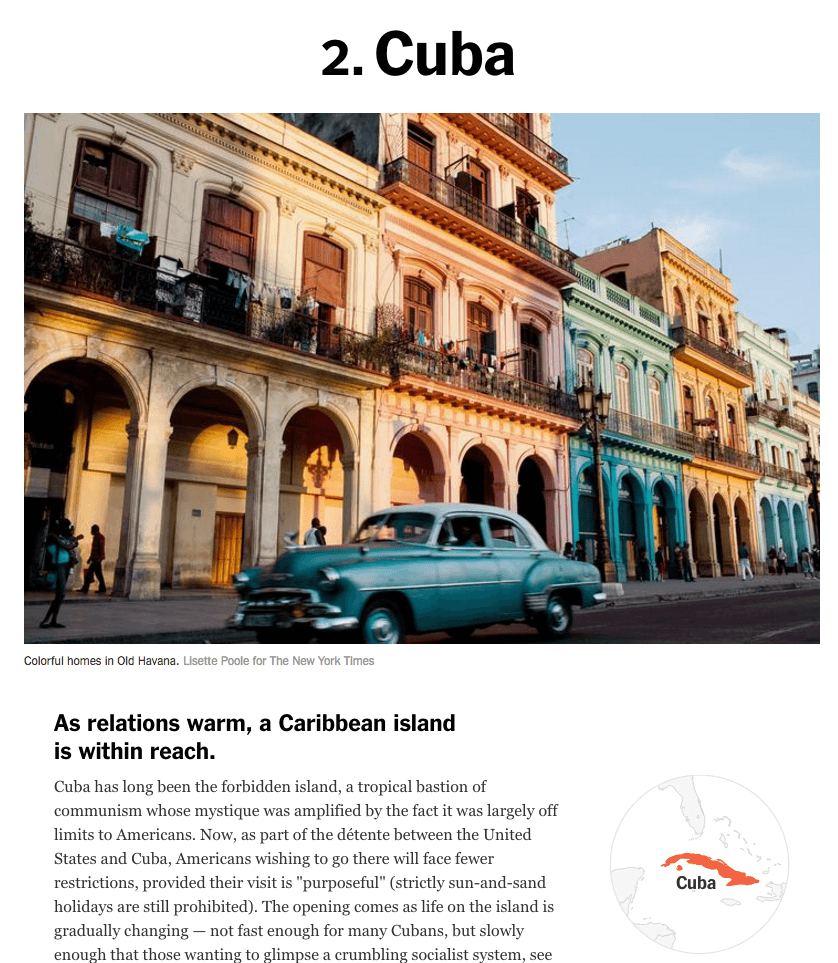
The post puts images in the spotlight, using big, beautiful images and smaller blocks of supplementary text. It even mixes photos and videos seamlessly. The map is a nice way to incorporate a supplementary visual. The post is organized in a simple and clean way, so the images don’t get lost.
When you check out the post on mobile, the text folds into a hidden block, so the format is even more visually appealing.
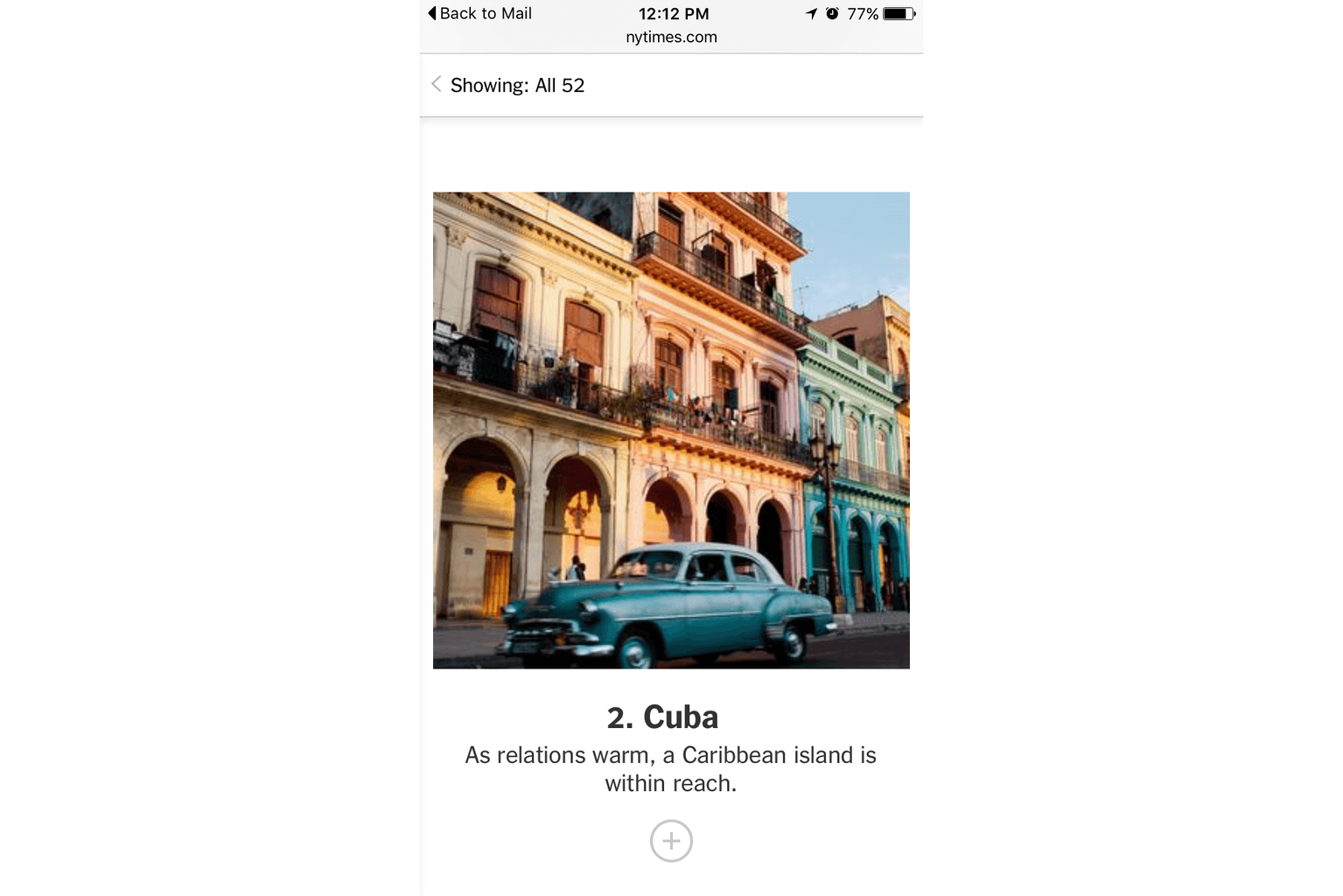
The Takeaway: Listen to the research. Lists and visual content are tried and true formats for driving engagement, and when you put them together, you get a compelling and shareable piece of content.
Dive into Your Archive: The Digs
People love to take a trip back in time. The Pittsburgh Post-Gazette is celebrating its 230th anniversary in 2016, and the newspaper is seizing a unique opportunity to give readers a window into the past. The news team mines the paper’s unmatched photo archive for interesting images, and creates slideshows and stories about them for a column called, “The Digs.”
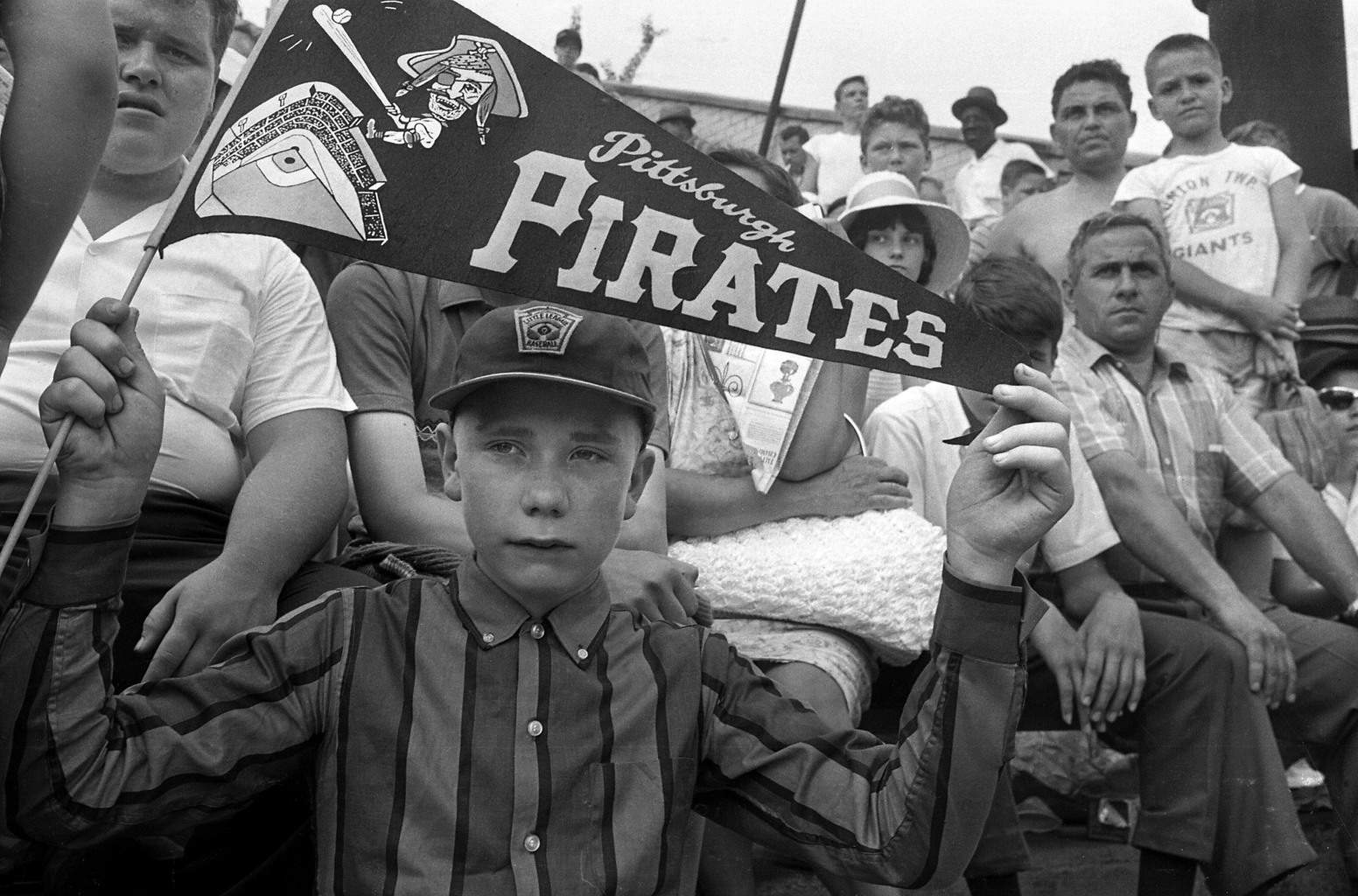
By leveraging its photo archive, the Pittsburgh Post-Gazette is creating something new for its audience.
The Takeaway: Does your organization have old photos that would mean something special to your audience? Think about the #ThrowbackThursday potential here. Leveraging your organization’s past can give your fans a chance to reminisce about your brand. (To see the full story about “The Digs,” check out our feature, Pittsburgh Post-Gazette Digs into its Photo Archive.)
Leave Them Wanting More: Hello
I know what you’re thinking. “Hello! I am not Adele! How can I copy her?!” Well, you might not be able to sing like Adele, but you can still take some inspiration from her brilliant marketing.
Before the singer launched her wildly popular Hello video and released her chart-topping album, 25, this commercial ran during X Factor on British television.
Snippet from Adele’s new album. pic.twitter.com/ThSvnRREaB
— My Daughter’s Army (@mydaughtersarmy) October 18, 2015
The snippet created a frenzy of excitement on social media. Through it all, Adele and her team stayed quiet, letting the momentum build. The Adele camp’s silence only made people talk more. When Hello finally launched, it was viewed over 27.7 million times in just the first day.
The Takeaway: The Hello preview was the tip of the iceberg – just a little hint to create buzz. How can you spark excitement with your customers? What will leave them wanting more?
Seize the Moment: The Cheerios Superbowl Tweet
The Superbowl has become the Brand Bowl, not just on television but also on social media. Brands armed with photos, puns and hashtags monitor the game (and the ads) in real-time war rooms to send out witty tweets at the perfect time.
During Superbowl XLIX, Cheerios won the Twitter game with this tweet seconds after a game-winning interception on the goal line.
Everyone’s mouth right now: pic.twitter.com/cZjfD42kgK
— Cheerios (@cheerios) February 2, 2015
A simple picture and a simple caption crushed the competition and stole the show, right at the perfect moment.
The Takeaway: Whether or not your brand is big enough to have an ad in the Superbowl, you should pay attention to current events and trends and think about how your brand can have an impact. Weighing in at the right time can lead to a big win for your organization.
Repurpose Valuable Content: An in-depth look at cleaner cookstoves
The Global Alliance for Clean Cookstoves teamed up with Shell to create a powerful visual storytelling campaign. One of the most important elements was file footage the nonprofit had shot for another project years earlier.
Some of the most powerful moments, like when the smoke encircles a woman cooking and illustrates the dangers of cookstove smoke, were shot for another project. The Global Alliance for Clean Cookstoves keeps a well-organized media library, and was able to repurpose this valuable content when they got the opportunity to run these PSAs as part of Shell’s Make the Future campaign.
The Takeaway: Recognize the value of your visual content. Photos and video you shoot for one project may prove to be valuable for a new project down the road. Keep an organized visual media library so you can leverage your visual assets when a new opportunity presents itself.
Make Bite-Sized How-To’s: Tasty’s Recipe Videos
The Buzzfeed brand Tasty has mastered the bite-sized how-to video, producing quick videos tailored to each of its social media channels. The videos are shot consistently from above, showing a first-person perspective of the making of each recipe.
Homemade Ferrero Rocher-Inspired Balls (via Proper Tasty)
Posted by Tasty on Wednesday, January 6, 2016
They are perfect for Facebook autoplay, because they are colorful and fast paced, and they’re over before you start scrolling again. They’re snackable, if you will.
The Takeaway: How-to’s consistently rank at the top of the list of most engaging content formats (especially in B2B). But they could benefit from mixing it up a little. Think about how you can improve those how-to’s with short-form, eye-catching content that amuses and helps your customers (and doesn’t bore them).
Embrace Self-Awareness: Unskippable
The social media landscape is constantly changing. Brands have to adapt their content to the channels they use to distribute it. But this is a daunting task, and sometimes it’s hard for brands to keep up. A perfect example: YouTube’s preroll ads. Many viewers don’t watch an ad beyond the “skip” button, and miss the brand’s punchline because the content is not tailored to the skip function.
Geico, however, created a campaign that surprised customers by adapting to the medium and blatantly acknowledging what we all know: no one watches the whole ad.
The brand had research that backs up what you might expect – the majority of viewers were skipping the preroll ads after five seconds. The “unskippable” ads highlight the brand’s self-awareness, and fill everything after those five seconds with hilarious content that gives the audience a reason to keep watching.
“If we’re going to interrupt someone on their way to watch something they actually sought out, and want to watch, we better make it worth their while,” Geico’s The Martin Agency account director told Adweek.
The Takeaway: The self-awareness of this campaign made viewers feel like they were part of an inside joke with Geico. Embrace your brand’s self-awareness, and create a sense of familiarity with your followers.




